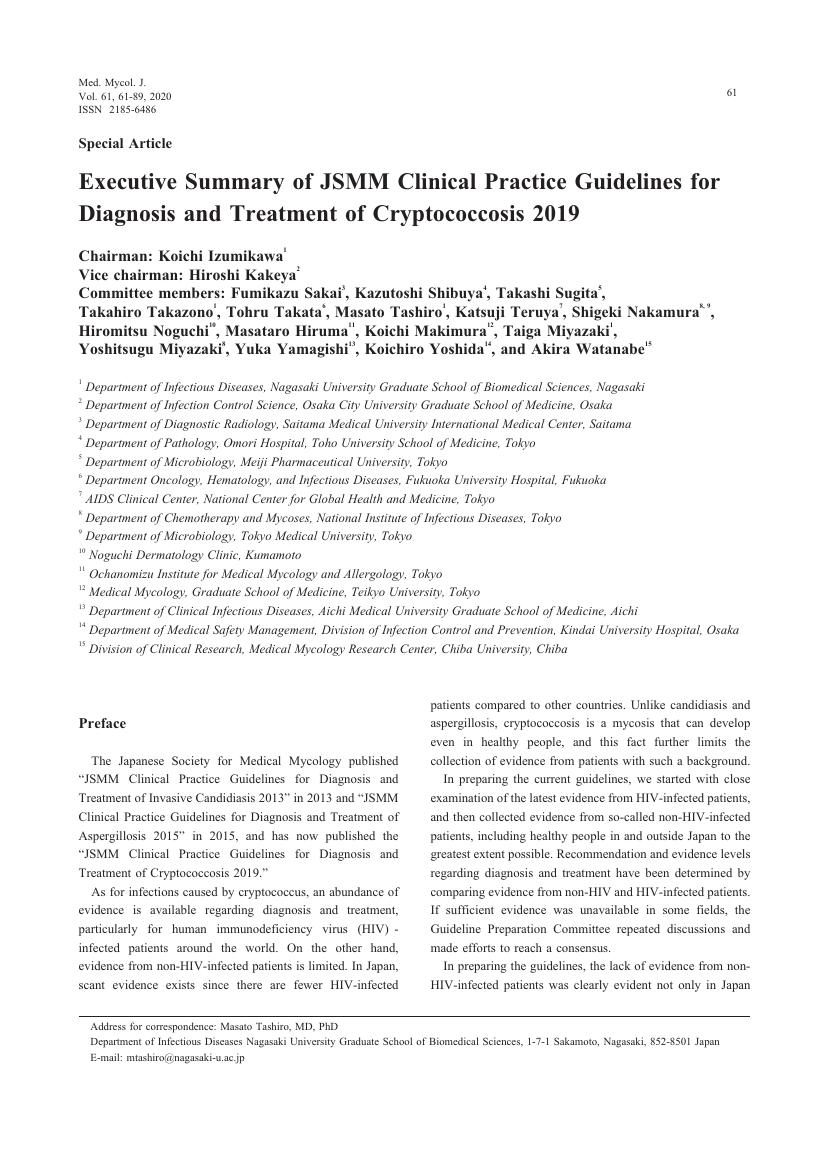- 著者
- Noriko Nakajima Satoru Hata Yuko Sato Minoru Tobiume Harutaka Katano Keiko Kaneko Noriyo Nagata Michiyo Kataoka Akira Ainai Hideki Hasegawa Masato Tashiro Makoto Kuroda Tamami Odai Nobuyuki Urasawa Tomoyoshi Ogino Hiroaki Hanaoka Masahide Watanabe Tetsutaro Sata
- 出版者
- National Institute of Infectious Diseases
- 雑誌
- Japanese Journal of Infectious Diseases (ISSN:13446304)
- 巻号頁・発行日
- vol.63, no.1, pp.67-71, 2010-01-29 (Released:2022-03-31)
- 参考文献数
- 1
- 被引用文献数
- 2 57
We report the pathological and virological findings of the first autopsy case of the 2009 pandemic influenza (A/H1N1pdm) virus infection in Japan. A man aged 33 years with chronic heart failure due to dilated cardiomyopathy, mild diabetes mellitus, atopic dermatitis, bronchial asthma, and obesity died of respiratory failure and multiple organ dysfunction syndrome. Macroscopic examination showed severe plumonary edema and microscopically the lung sections showed very early exudative-stage diffuse alveolar damage (DAD). Immunohistochemistry revealed proliferation of the influenza (A/H1N1pdm) virus in alveolar epithelial cells, some of which expressed SAα2-3Gal on the cell surface. Influenza (A/H1N1pdm) virus genomic RNA and mRNA were also detected in alveolar epithelial cells. Real-time PCR revealed 723 copies/cell in the left lower lung section from which the influenza (A/H1N1pdm) virus was isolated. Electron microscopic analysis revealed filamentous viral particles in the lung tissue. The concentrations of various cytokines/chemokines in the serum and the autopsied lung tissue were measured. IL-2R, IL-6, IL-8, IL-10, IFN-α, MCP-1, and MIG levels were elevated in both. These findings indicated a case of viral pneumonia caused by influenza (A/H1N1pdm) virus infection, showing characteristic pathological findings of the early stage of DAD.
- 著者
- Katsuhisa Kuwano Yuki Ota Kiyokazu Tsuji Kenta Torigoe Ayuko Yamashita Kumiko Muta Mineaki Kitamura Hiroshi Yamashita Tadashi Uramatsu Masato Tashiro Hiroko Hayashi Koichi Izumikawa Hiroshi Mukae Tomoya Nishino
- 出版者
- The Japanese Society of Internal Medicine
- 雑誌
- Internal Medicine (ISSN:09182918)
- 巻号頁・発行日
- pp.7332-21, (Released:2021-08-13)
- 参考文献数
- 18
- 被引用文献数
- 3
A 68-year-old woman developed systemic blisters while receiving treatment for nephrotic syndrome. As she also developed marked liver dysfunction and disseminated intravascular coagulation, she was admitted to our hospital. She was diagnosed with varicella zoster virus (VZV) infection. Treatment was administered in the intensive-care unit, but the patient died on day 24 post-admission after severe VZV infection. A post-mortem examination showed micro-abscesses and necrosis caused by varicella zoster infection in multiple organs, including the liver, kidneys, and gastrointestinal tract. Because VZV infection can become severe in immunocompromised patients, careful consideration is needed for the prevention and treatment of the viral infection.
- 著者
- Koichi Izumikawa Hiroshi Kakeya Fumikazu Sakai Kazutoshi Shibuya Takashi Sugita Takahiro Takazono Tohru Takata Masato Tashiro Katsuji Teruya Shigeki Nakamura Hiromitsu Noguchi Masataro Hiruma Koichi Makimura Taiga Miyazaki Yoshitsugu Miyazaki Yuka Yamagishi Koichiro Yoshida Akira Watanabe
- 出版者
- The Japanese Society for Medical Mycology
- 雑誌
- Medical Mycology Journal (ISSN:21856486)
- 巻号頁・発行日
- vol.61, no.4, pp.61-89, 2020 (Released:2020-11-30)
- 参考文献数
- 39
- 被引用文献数
- 7
- 著者
- Tsuyoshi Ogata Yoshinao Yamazaki Nobuhiko Okabe Yosikazu Nakamura Masato Tashiro Noriko Nagata Shigeyuki Itamura Yoshinori Yasui Kazutoshi Nakashima Mikio Doi Youko Izumi Takashi Fujieda Shin'ichi Yamato Yuichi Kawada
- 出版者
- Japan Epidemiological Association
- 雑誌
- Journal of Epidemiology (ISSN:09175040)
- 巻号頁・発行日
- pp.0807040024, (Released:2008-07-07)
- 参考文献数
- 20
- 被引用文献数
- 28 30
Background: H5N2 avian influenza virus infection of humans has not been reported thus far. The first H5N2 avian influenza infection of poultry in Japan occurred in Ibaraki. Methods: The subjects were workers at 35 chicken farms in Ibaraki Prefecture, where the H5N2 virus or antibody was isolated from chickens. None of the subjects exhibited influenza symptoms. The H5N2-neutralizing antibody titers of the first and second paired sera samples were compared. To investigate the possible factors for this increase, the H5N2-neutralizing antibody titer (1:40 or more) was calculated for the second samples. A logistic regression analysis was performed to examine the association of these factors with H5N2-neutralizing antibody positivity. Results: We performed Wilcoxon matched-pairs signed-ranked test on data collected from 257 subjects, and determined that the H5N2 antibody titers of the second paired sera samples were significantly higher than those of the first samples (P < 0.001). The H5N2 antibody titers of paired sera of 13 subjects without a history of seasonal influenza vaccination within the previous 12 months increased 4-fold or more. The percentage of antibody positivity was 32% for subjects with a history of seasonal influenza vaccination (28% of all subjects) and 13% for those without a history of the same. The adjusted odds ratio of H5N2-neutralizing antibody positivity was 4.6 (95% confidence interval: 1.6-13.7) for those aged over 40 and 3.1 (95% confidence interval: 1.6-6.1) for those with a history of seasonal influenza vaccination within the previous 12 months. Conclusion: The results suggest that this may have been the first avian influenza H5N2 infection of poultry to affect humans. A history of seasonal influenza vaccination might be associated with H5N2-neutralizing antibody positivity.
